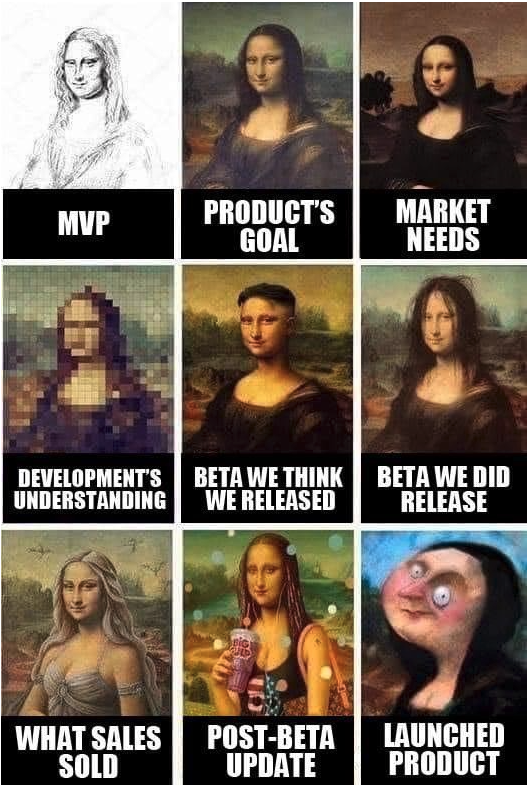
Congratulations, you’re plotting your brand new digital project! Chances are, you’ve been advised to try doing a minimum viable product. Most people assume it’s a tech term, or a type of process,but an MVP is really an organisational mindset. Let’s take a look at two common mindset pitfalls companies and agencies face when building MVPs - trying to fight uncertainty and creating sloppy user experiences.
MVP Origins
Over the last few years startup culture influenced businesses to start ditching long, complex processes and try to be more ‘agile’ and flexible instead. In particular, the idea of the minimum viable product (MVP) is now part of the conversation in almost every new product development team. Eric Ries, the famous author of “The Lean Startup” coined the term as “that version of a new product which allows a team to collect the maximum amount of validated learning about customers with the least effort.” In simple terms, this means launching the product as quickly as possible, while minimising risks and investment, as opposed to working tirelessly on something that might turn out to be wrong from the start.
Ever since the book grew in popularity, enterprises and startups have been taking notes, trying to adopt its best practices and build the next big thing. So far, so good. But if it was as simple as that, we wouldn’t have 9 out of every 10 startups fail. Of course, there are various reasons for the high failure rate of startups, but even Eric Ries admits the MVP concept is difficult to put into practice. Some even say that over the last few years MVPs have started to mutate into a Godzilla-like form that does more harm than good.
MVP is about uncertainty
The famous drawing by Henrik Kniberg about MVPs has been shared and reposted time and time again, yet some people still don’t quite agree that it makes sense to build a bicycle first, before building a car. Kniberg wrote an article himself, explaining in detail what he meant, so if you are perplexed too, now’s a good time to go ahead and read it.

Source: Henrik Kniberg
What makes the MVP concept so difficult to implement by companies and agencies alike is the fact that it goes hand in hand with uncertainty and doubt. Usually, good business practice is about eliminating uncertainty and risk through rigorous research and planning. Projects are also about maximising certainty: from identifying customer requirements to meeting them within a certain timeframe, all within a clearly defined brief.
What we have noticed, though, is many of our clients actually don’t know what they need, or they don’t know how to describe it. Or, they might describe a solution, rather than the underlying problem it’s solving, thus overlooking more creative, innovative solutions. In a case like this, by skipping the MVP we’d be fast and efficient at building a product that might be completely redundant...
If the customer truly knows what they need, including what outcomes they are hoping to achieve and how this solution will provide those outcomes, then, sure, we can go and build that. But most of the time, we barely have that level of certainty.
So no wonder products that are deemed ‘MVPs’ but are built on a predefined scope, features and a timeline don’t lead anywhere. Releasing half-baked features smashed into a poorly constructed version of a product is not an MVP. It’s a trainwreck with a fancy ‘MVP’ label on it.

Image Credit: Product Management Memes FB Page
Instead, what Eric Ries preached all along was to embrace uncertainty. Companies and agencies alike should embrace the bitter truth that they might not know it all. If you want to benefit from the cost-effectiveness and speed of MVPs, be prepared to doubt your ideas and to take one step back, before taking two steps forward.
Too much ‘minimum’ and not enough ‘viable’
Viable, (n.): capable of working successfully; having the ability to grow or function properly
The MVP approach is focusing on core elements of a product that appeal to early adopters, then building up from there as customer needs are uncovered. At its core, the MVP is about minimising wasted effort - not developing features that are not yet proven to be of value to users. And for that reason, we prioritise them, count them, and try to optimise the number of features we implement. The product management community has often been criticised for its obsession with features. By focusing just on the minimum and skipping the ‘viable’, MVPs have mutated into sloppy, hideous product representations.

Source: UX Design
Using a poorly executed MVP to test the market will likely result in negative market feedback, even if your initial concept is good. This is because users don’t care about features, they care about solutions to their problems.
So from this perspective, the MVP is not so much about finding the minimum amount of features that will make a user happy - rather about experimenting and prototyping your way into a meaningful product experience. Taking a more balanced approach to product development means thinking about how the product ‘works’, just as much as about how the user will experience it. Some have taken this stance even further by creating minimum lovable products (MLPs) instead.
MLP: The version of a new product that brings back the maximum amount of love from your early tribe members with the least effort.
Ready to shake things up?
Minimum viable products are definitely famous for a reason. When executed properly, they are an incredibly powerful product development tool. They either give you confidence that your product is indeed worth developing, or they save you tons of cash when your idea is not viable. But making your MVP work takes dedication and a down-to-earth attitude from both companies and agencies.
Over the last 14+ years, we have built, tested and released numerous successful products and MVPs in various sectors and industries. we're pretty confident that we know how this works. If you are looking for a partner to help you build the real deal, get in touch with us. We have a proven track record and we can support you in clarifying and developing your proposition.





